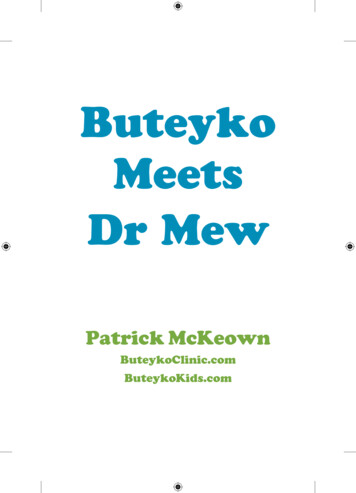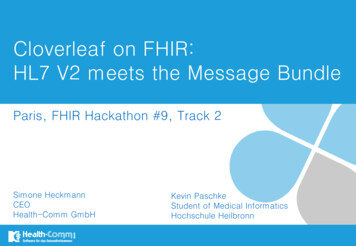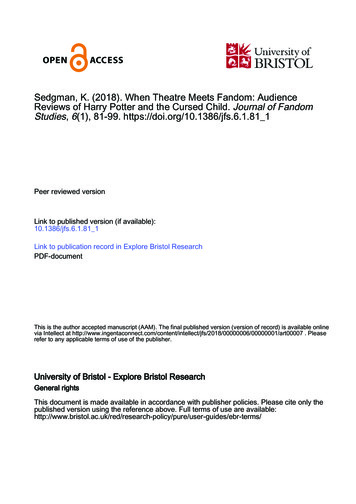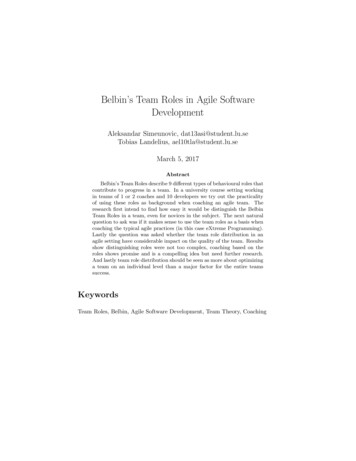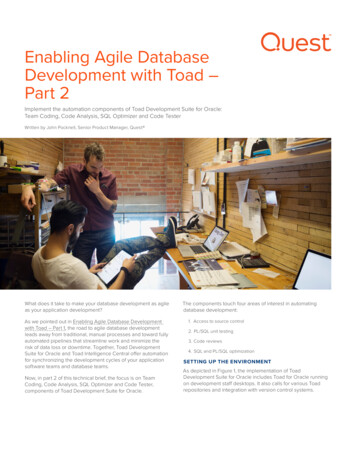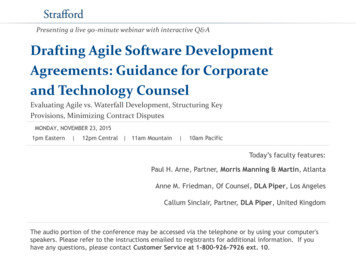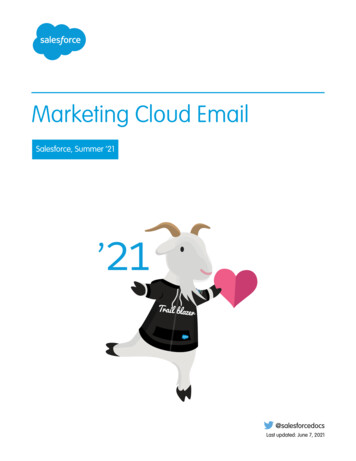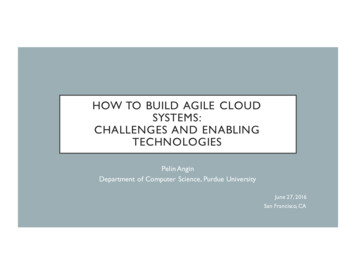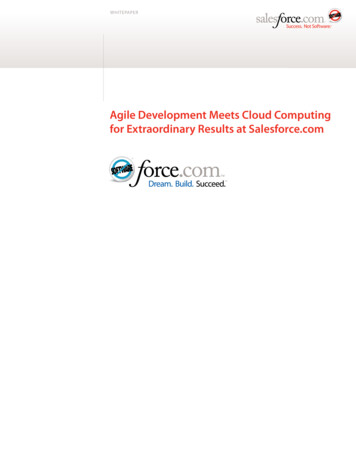
Transcription
WHITEPAPERAgile Development Meets Cloud Computingfor Extraordinary Results at Salesforce.com
WHITEPAPERContentsExecutive Summary . . 2Agile Development Brings Dramatic Improvements. 2Agile Development Benefits: Predictability, Transparency, & Energy. 3Predictability.3Transparency.4Energy.4Bringing Agile Development to Salesforce.com. 4The Challenges of Converting to Agile Development.4The Tipping Point.5Lessons Learned.5Computing and Agile Development: A Great Combination. 6Agile Development Meets Cloud Computing for Extraordinary Results at Salesforce.com1
WHITEPAPERExecutive SummarySince agile development was invented in the mid-1990s, it has revolutionized how software iscreated by emphasizing short development cycles based on fast customer feedback.With agile development, the application is constantly subjected to the reality check of actual usersputting it through its paces. As a result, developers are less likely to get ahead of themselves byguessing what people will want. Nor are programming teams forced to estimate what they candeliver months in advance—an unattainable feat. Instead, R&D is more likely to build featurespeople actually want. And because developers are looking ahead for weeks, not months, major newreleases are far more likely to be delivered on time. Developers using this methodology call theprocess “continuous improvement.” For the organizations that have made this process work forthem, there is no going back.But for much of its history, agile development was missing a crucial component: a developmentplatform that supports, rather than thwarts, the rapid development cycles that make themethodology work. In traditional software environments, new software distribution is an ordealthat requires patches, reinstallation, and help from the support team. In such an environment,months or even years are needed to get a new distribution into the hands of users. Incorporatingtheir feedback into the next release then requires comparable time.It is here that cloud computing makes a substantial difference. Cloud computing eliminates thecumbersome distribution requirements that can bring agile development to a crawl. There are nopatches to distribute, and no reinstallations are needed. With cloud computing, new distributionsare installed on hosted servers and made available to users immediately. As a result, it’s possiblethat the application you run today was modified just the night before. Looking back with 20-20hindsight, it’s clear that cloud computing is the component agile development has been waiting for.One of the best examples of bringing together agile development and cloud computing is theexperience of salesforce.com where, in late 2006, the R&D team moved to agile development.Few enterprise companies have adopted agile development as successfully as salesforce.com. Thereason now seems clear: agile development was made to order for the Force.com platform—andvice versa—by leveraging the advantages of cloud computing. After just 2 weeks of training, thedevelopment staff, consisting of 30 teams, made the transition to agile development.As salesforce.com has shared its experience with agile development on the Force.com platformwith its customers, many have reported comparable successes. This paper shows the dramatic resultspossible when agile development meets Force.com.Agile Development Brings Dramatic ImprovementsIn the last 7 years, salesforce.com’s R&D organization has grown from a small team of developersto a large, cross-functional organization. As the organization scaled up and the complexity of theservice increased, release dates for major releases began to slip. By 2006, during the last of thecompany’s “pre-agile” days, salesforce.com had dropped from four seasonal releases down to one—adevelopment that goes against the very grain of cloud computing. That release, which took about15 months to complete, was the wakeup call the company needed to make a radical change in itsdevelopment process.That change was agile development. Since moving to this model, R&D has deployed each of the foursuccessive major releases on the day it was scheduled. Salesforce.com is back on a regular deliveryschedule, and R&D is confident that new releases will continue to be delivered on time, every time.Figure 1 compares pre- and post-agile development timelines and releases at salesforce.com.2Agile Development Meets Cloud Computing for Extraordinary Results at Salesforce.com
WHITEPAPERFigure 1: Pre- and post-agile development at salesforce.com.Salesforce.com’s R&D organization has benefitted in several ways from its transition to agiledevelopment:::: Increased delivery rate and created a process that makes customers and R&D happy::: Increased time to market of major releases by 61 percent::: Achieved a Net Promoter Score of 94 percent, a good indicator of customer satisfaction::: Convinced 90 percent of the R&D team to recommend the methodology to colleagues insideand outside the company::: Increased productivity across the organization by 38 percent, as measured by the number offeatures produced per developer (a side benefit not anticipated as part of the original goals)Some salesforce.com customers have followed this example and benefitted as well. For example,CODA used agile development in developing CODA 2go, a new software-as-a-service (SaaS)accounting application built natively on the Force.com platform. Product Director Debbie Ashtonreports that the agile approach encouraged the development team to break the process into smaller,more manageable stages, leading to more accurate delivery forecasts and faster time to market.She also credits the approach for making development more transparent, allowing stakeholdersto see and influence product functionality earlier and resulting in features that map more closelyto requirements. In turn, the team gained a better appreciation of how requested changes areprioritized, while being “more agile” in its ability to change focus.Agile Development Benefits: Predictability, Transparency, & EnergyFor salesforce.com, the agile development methodology provides three main benefits:::: Predictability through “timeboxing”::: Transparency::: Energy, fueled by creativity and job satisfactionPredictabilitySalesforce.com’s number-one goal in moving to agile development was a more predictable releasecycle. In conventional “waterfall” development, an organization tries to predict what functionalitycan be delivered 6 months to 1 year out—and makes promises it cannot keep because of largeunknowns in the cycle.Agile development’s answer to this dilemma is counter-intuitive: predictability comes whenreleases are “timeboxed,” keeping the date, resources, and quality control fixed while keepingfunctionality decisions flexible. Salesforce.com now segments its releases into smaller pieces, witha narrower scope that can be completed in 1 month or less. Compare this process with a waterfallprocess, in which priorities are set at the beginning of the new cycle and never benefit fromcustomer feedback until months or even years later.Agile Development Meets Cloud Computing for Extraordinary Results at Salesforce.com3
WHITEPAPERShorter cycles can incorporate customer feedback quickly into the next major release. Shortercycles have also increased the importance of maintaining a priority list and focusing, with laser-likeattention, on the items at the top of that list. Customer feedback allows constant reassessment ofthe list, and, if necessary, reprioritization for the next cycle. In this process, it helps to have a strongconduit to the user community, which the team has built with salesforce.com’s IdeaExchangecustomer forum.The agile development value of promising only what you can deliver is also evident in the “sprintreviews” held at the end of each iteration cycle. These sessions let teams show the organization whatthey’ve accomplished. Teams only show work that is ready to ship; work in progress is not factored in.TransparencyForce.com platform division head Steve Fisher is fond of saying that agile development hasgiven him the best handle on the state of an R&D team in his 25-year career. The key to thisbreakthrough is transparency made possible by a set of engineering practices that includescontinuous integration, unit and functional test automation, and daily meetings and information“radiators” that continually show the progress of every team, displayed on a wall for all to see.Salesforce.com has also made transparency an external value, thereby building trust with thecustomer base. The company now provides customers with readouts of the state of the system overthe last 30 days at http://trust.salesforce.com. This practice contrasts with the usual approach ofhiding problems from the outside world. With Salesforce CRM, if things go wrong, customers cansee any problems and how they are being resolved.EnergyAgile development has helped recapture the spirit of creativity and excitement that markedsalesforce.com’s days as a startup. As companies grow, the centralized decision-making process thathas served them well sometimes begins to strangle creativity. Agile development helps decentralizethe process by pushing responsibility and decision-making to the development teams.Continuous improvement—an agile development cornerstone—also creates a better workexperience because everyone from developers and QA engineers to documentation writers canimprove how they work individually and contribute to how the team functions. Productivity is itsown reward. And when you give smart, capable people a tangible sense of accomplishment, jobsatisfaction rises.Bringing Agile Development to Salesforce.comIn making the dramatic switch to an agile development methodology, salesforce.com technicalpersonnel began with an important premise: that this methodology was true to the company’s corevalues—keep it simple, iterate, and listen to your customers. In a way, agile development recapturedthe spirit of the startup salesforce.com once was.The Challenges of Converting to Agile DevelopmentTo begin the process, a newly formed cross-functional team vetted the initial proposal in 45 1-hourmeetings with key stakeholders at all levels of the organization. Feedback from each stakeholderwas incorporated into the proposal document, which was presented to the technical executive teamat an offsite.Once the team had the green light, it took a “big bang” approach: converting the entireorganization overnight. The move was not without risks. Skeptics argued that several teams mightrepeat mistakes that could be caught by a few starter teams. They were also concerned therewouldn’t be enough coaches to assist the teams every day. On the other hand, a big-bang rolloutwould avoid organizational dissonance and send a clear signal that salesforce.com was takingdecisive action.An early step in the transformation was to send a large group of engineers to Certified ScrumMastertraining and to seed the office with agile development books, while the cross-functional teamdeveloped a presentation and training deck. All 30 teams participated in 2-hour training sessions;a wiki-based Web site was created to house everything related to agile development.4Agile Development Meets Cloud Computing for Extraordinary Results at Salesforce.com
WHITEPAPERThe biggest hurdle wasn’t the mechanics of agile development, but the mindset of the teammembers. The methodology required a different way of thinking, which can be difficult if you’vebeen developing for a decade or two. People weren’t shy about letting the team know what theythought, with comments like these: “We spend more time talking about scrum than we spend timeworking on Salesforce”; “Stop trying to implement scrum and look at how many releases we can really do ina year”; and “The lingo is ridiculous.”The Tipping PointThe tipping point in favor of the adoption of agile development came about 4 months into thetransition. As people started to master the mechanics, they voiced fewer frustrations. The rolloutteam received fewer negative comments. The release schedule became more predictable and regular.Gradually, the entire group realized that agile development was worth the effort.Since the initial rollout, salesforce.com has made continuous improvements to agile development bydividing the process into four phases: rollout, adoption, excellence, and expansion, as shown in Figure 2.Figure 2: The agile development process at salesforce.com.An early milestone in continuous improvement was the development of Scrumforce, an internalbacklog management tool built in just 3 weeks on the company’s Force.com platform using theForce.com Apex programming language and the Visualforce user interface devel
Salesforce.com now segments its releases into smaller pieces, with a narrower scope that can be completed in 1 month or less. Compare this process with a waterfall process, in which priorities are set at the beginning of the new cycle and never benefit from customer feedback until months or even years later. WHITEPAPER 4 Agile Development Meets Cloud Computing for Extraordinary Results at .


